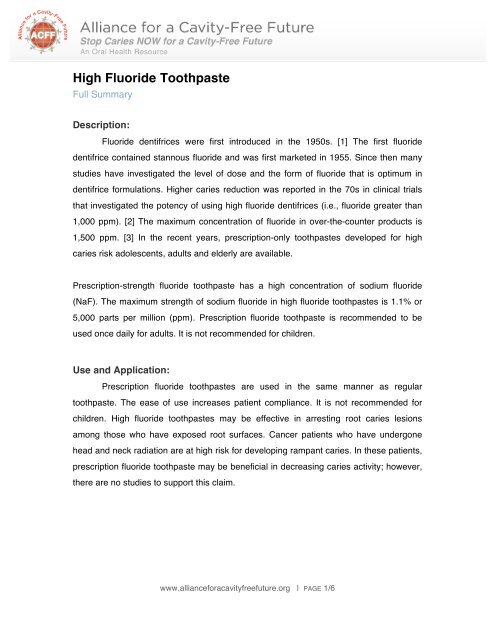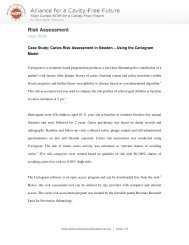High Fluoride Toothpaste Full - Alliance for a Cavity-Free Future
High Fluoride Toothpaste Full - Alliance for a Cavity-Free Future
High Fluoride Toothpaste Full - Alliance for a Cavity-Free Future
You also want an ePaper? Increase the reach of your titles
YUMPU automatically turns print PDFs into web optimized ePapers that Google loves.
<strong>High</strong> <strong>Fluoride</strong> <strong>Toothpaste</strong><strong>Full</strong> SummaryDescription:<strong>Fluoride</strong> dentifrices were first introduced in the 1950s. [1] The first fluoridedentifrice contained stannous fluoride and was first marketed in 1955. Since then manystudies have investigated the level of dose and the <strong>for</strong>m of fluoride that is optimum indentifrice <strong>for</strong>mulations. <strong>High</strong>er caries reduction was reported in the 70s in clinical trialsthat investigated the potency of using high fluoride dentifrices (i.e., fluoride greater than1,000 ppm). [2] The maximum concentration of fluoride in over-the-counter products is1,500 ppm. [3] In the recent years, prescription-only toothpastes developed <strong>for</strong> highcaries risk adolescents, adults and elderly are available.Prescription-strength fluoride toothpaste has a high concentration of sodium fluoride(NaF). The maximum strength of sodium fluoride in high fluoride toothpastes is 1.1% or5,000 parts per million (ppm). Prescription fluoride toothpaste is recommended to beused once daily <strong>for</strong> adults. It is not recommended <strong>for</strong> children.Use and Application:Prescription fluoride toothpastes are used in the same manner as regulartoothpaste. The ease of use increases patient compliance. It is not recommended <strong>for</strong>children. <strong>High</strong> fluoride toothpastes may be effective in arresting root caries lesionsamong those who have exposed root surfaces. Cancer patients who have undergonehead and neck radiation are at high risk <strong>for</strong> developing rampant caries. In these patients,prescription fluoride toothpaste may be beneficial in decreasing caries activity; however,there are no studies to support this claim.www.alliance<strong>for</strong>acavityfreefuture.org | PAGE 1/6
Effectiveness and Efficacy:Studies on ,1500-2,800 ppm fluoride dentifrice:Prescription fluoride toothpaste has been used <strong>for</strong> several years in preventingcaries and arresting existing caries. In the 1970s, five clinical trials conducted in Europeevaluated the caries incidence in children following use of high-potency fluoridedentifrices compared to children who did not use fluoride dentifrices. [2] The fluorideconcentrations in these trials ranged from 1,500 ppm to 2,600 ppm. On average amongthe trials there was a statistically significant caries reduction of 24%. Following this in the1980s, six clinical studies compared 1,450-2,800 ppm sodium fluoride or sodiummonofluorophosphate dentifrices to conventional fluoride dentifrices. Four of thesestudies were conducted in the U.S. The studies reported that the use of high-potencyfluoride dentifrices significantly decreased the DMFS when compared to theconventional dentifrices.In a recent Cochrane review (2010) 75 studies were included, of which 71 studiescomprising 79 clinical trials contributed data to the meta-analysis 5 . For 66 studies thatcontributed to the meta-analysis of D(M)FS in the mixed or permanent dentition, thecaries preventive effect of fluoride toothpaste increased significantly with higher fluorideconcentrations. The (D(M)FS <strong>for</strong> permanent dentition when compared to placebo was23% <strong>for</strong> 1,000/1,055/1,100/1,250 parts per million (ppm) concentrations and increasingto 36% <strong>for</strong> toothpastes with a concentration of 2,400/2,500/2,800 ppm). Lowerconcentrations of 440/500/550 ppm and below showed no statistically significant effect.In this Cochrane review, six studies that assessed the effects of fluoride concentrationson the primary dentition showed similar results that depended on the fluorideconcentrations in toothpastes.The anti-caries efficacy of four different fluoride toothpastes were evaluated in a largeclinical study that included 5,439 schoolchildren aged 6-15 years.[6-8] The fourconcentrations of toothpastes that were evaluated in this study are 1,100, 1,700, 2,200,www.alliance<strong>for</strong>acavityfreefuture.org | PAGE 2/6
and 2,800 ppm. The subjects were recruited from an urban area in Ohio with lowfluoride in the water supply (
fluoride dentifrice. [11] The 5,000 ppm gel used in this study has been re<strong>for</strong>mulated andis used as a fluoride dentifrice containing 5000 ppm fluoride.In other clinical studies the effectiveness of 5,000 ppm fluoride toothpaste and 1,100ppm fluoride gel in arresting root caries was compared. [12, 13] A total of 201 subjectswith at least one root carious lesion were recruited and randomly assigned to 5,000 ppmfluoride toothpaste or 1,100 ppm fluoride gel. Caries lesions were measured at baselineand after 3 months by a single examiner. At the end of 3 months, arrested caries lesionswere observed among 38% of those who used the 5,000 ppm toothpaste compared to11% of those who used the 1,100 ppm gel. The short duration of this study is a limitation.Overall, few studies have been conducted on assessing effectiveness of 5,000 ppmfluoride toothpaste. The studies that have been conducted have limitations. There<strong>for</strong>e,the evidence <strong>for</strong> the highest concentration of fluoride toothpaste, while promising it is stillinsufficient. More studies are being conducted and future evidence may shed more lighton the effectiveness of high-fluoride toothpaste of 5,000 ppm.Summary and Recommendations:Based on the findings from the literature, the use of high fluoride dentifrice is effective inoverall caries reduction <strong>for</strong> concentrations above 1,500 ppm and up to 2,800 ppm. Theevidence <strong>for</strong> the highest concentration of 5,000 ppm is insufficient. The benefits ofconventional fluoride dentifrices may not suffice <strong>for</strong> those at high risk <strong>for</strong> caries. [3] <strong>High</strong>concentrations of fluoride may also be effective in arresting root caries lesions. [13] Mostof the studies on 1,500-2,800 ppm fluoride toothpastes have reported the effectivenessin caries prevention. In contrast, most of the studies on 5,000 ppm fluoride toothpastereport effectiveness in arresting existing caries. There is a need <strong>for</strong> future studies toinclude assessment of 5,000 ppm fluoride toothpaste on caries prevention. Whencompared to treatment procedures <strong>for</strong> caries in the dental office the use of high fluoridetoothpastes are more beneficial, easy to use and cost-effective. However, excellentpatient compliance is necessary. Safety in the use of these high concentration fluoridewww.alliance<strong>for</strong>acavityfreefuture.org | PAGE 4/6







